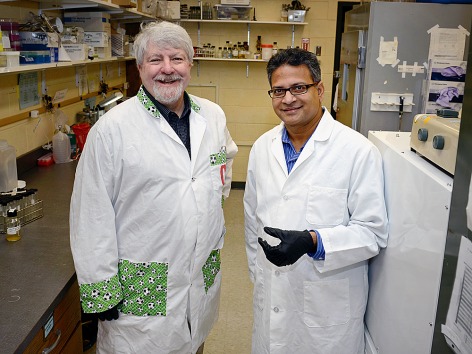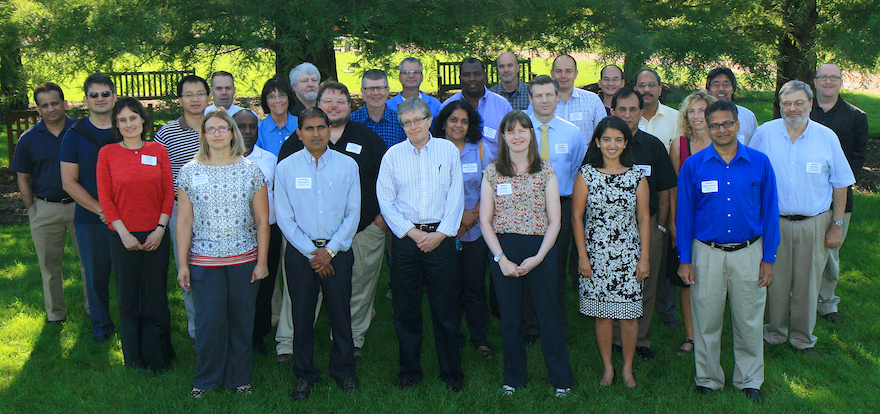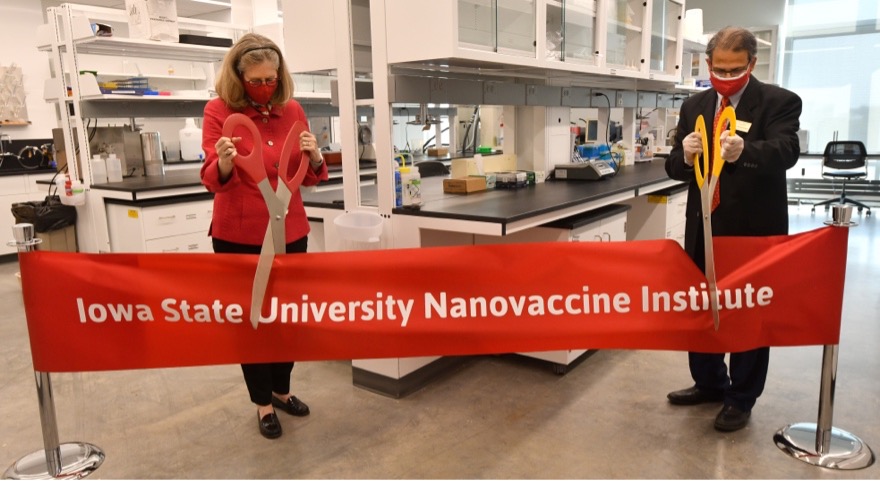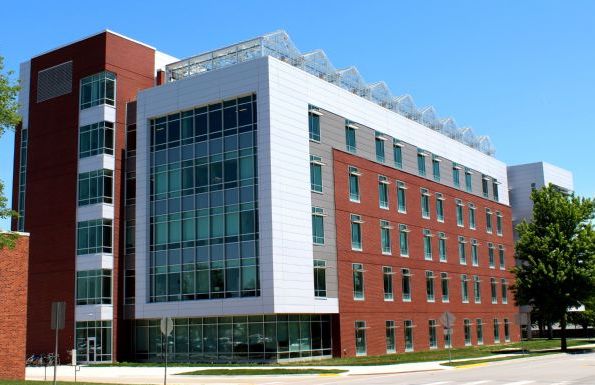History
Iowa State University colleagues Michael Wannemuehler, an immunologist in the College of Veterinary Medicine, and Balaji Narasimhan, a chemical engineer in the College of Engineering, began collaborating on nanovaccine research in 2001. Their initial goal was to use nanotechnology to develop single-dose vaccines for childhood immunizations, and for livestock diseases, both situations where not having to give booster doses would be a huge advantage.

Iowa State University colleagues Michael Wannemuehler (left) and Balaji Narasimhan, in the early days of their nanovaccine research. Narasimhan is holding a small vial of a nanovaccine formulation for pneumonia.
Narasimhan and Wannemuehler established a pattern of interdisciplinary teams. Narasimhan came to their projects as a polymer chemical engineer, while Wannemuehler was an immunologist with experience in animal models. Wannemuehler recalled, “I had no background in nanoparticles when I began the effort with Balaji. So the synergy was in bringing two very different fields together. We asked each other questions from a naive standpoint, and challenged each other, which made the research better.” Wannemuehler added, “We can’t all know everything. In most of our specialties, the more we learn, the less we know. It gets so sophisticated and complex in terms of how biology works, that having an interdisciplinary team becomes essential.”
“Having an interdisciplinary team becomes essential”
The interdisciplinary research team grew substantially in 2013, with support from a three-year, $1.2 million grant from Iowa State’s Presidential Initiative for Interdisciplinary Research. That project led by Narasimhan, “Systems Design of Nanovaccines,” assembled a diverse team of 43 immunologists, microbiologists, engineers, chemists, molecular biologists, biochemists, physicians, epidemiologists, economists, public policy experts, and entrepreneurs from 15 organizations. The project used a framework of five tightly integrated research thrusts to design nanovaccines against respiratory infections, neurodegenerative disorders, and cancer:
- novel antigen design and production;
- nanoscale adjuvants and delivery systems;
- vaccine efficacy and immunological mechanisms;
- scale-up, cGMP devices, and clinical testing; and
- global deployability and economic analysis.

Researchers at the first annual meeting of the Nanovaccine Initiative in 2014.
Under the umbrella of the Nanovaccine Initiative, the partners collaborated on interdisciplinary research funding proposals, winning grants and contracts from the National Institutes of Health, National Science Foundation, USDA, Department of Defense, foundations, and pharmaceutical companies. Since 2013 through 2021, Nanovaccine researchers have successfully competed for 46 major grant and contract awards, totaling about $47 million of research funding. As more researchers joined the consortium, the research focuses expanded beyond the initial respiratory infections, neural disorders, and cancer to include antimicrobial resistance, aging, and animal health. In addition to nanovaccines, the researchers began using the nanoparticle platform technology to develop nanotherapeutics for drug and chemotherapy delivery.
In 2017, the Iowa Board of Regents approved a request to upgrade the Nanovaccine Initiative to a stand-alone research center at Iowa State University—the Nanovaccine Institute. By then, the consortium had grown to 65 researchers from 19 organizations. The Nanovaccine Institute will expand on the strengths and potential of the Initiative to establish a premier research and translational center aimed at addressing emerging health issues through novel nanovaccine and nanotherapeutic technologies.
The proposal to the Iowa Board of Regents noted that the Nanovaccine Institute will establish:
- A scientific platform for collaborative interdisciplinary research aimed at producing efficacious, safe, and readily deployable therapies for existing and emerging diseases through novel nanovaccines and nanotherapeutics for respiratory infections, antimicrobial resistance, neural disorders, cancer, and animal health.
- A focus on deploying promising therapies to the market using public-private partnerships that translate promising approaches from laboratory-scale research studies to clinical trials via collaborations with industry and medical schools to commercialize emerging technologies.
- A supporting infrastructure to aggressively pursue a diversified portfolio of external funding, supported by expert grant writing and grant administration support to faculty teams for large-scale, multi-investigator research proposals.

In October 2020, Iowa State University President Wendy Wintersteen and Nanovaccine Institute Director Balaji Narasimhan performed a socially-distanced and masked ribbon-cutting for an online audience.
In 2020, the Nanovaccine Institute moved into new laboratory and headquarters space at Iowa State University. The fifth floor of the new Advanced Teaching and Research Building provides contemporary research laboratories (6,150 sq. ft.), common and specialized research support space (2,700 sq. ft.), conference rooms, and offices for faculty, scientists, and graduate students to support the efforts of the Nanovaccine Institute. This $7 million construction project consolidated scattered faculty, grad students, and lab resources under one roof for better collaboration, productivity, and efficiency.

The Nanovaccine Institute headquarters now occupy the 5th floor of the Advanced Teaching and Research Building at Iowa State University.



